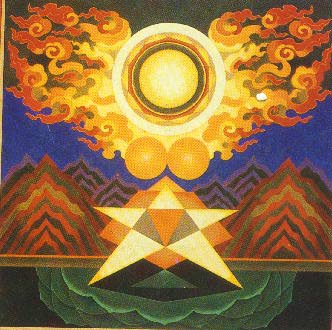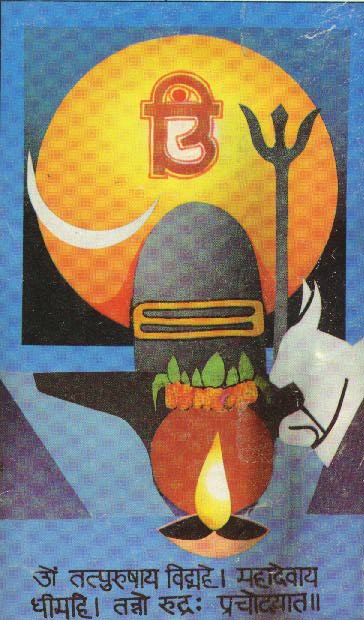Ghulam Rasul Santosh
(1929-97)
The
Painter of Divinity
It is hard to believe that the people of Kashmir, who could have built
such magnificent temples at Martand and Avantipur, could have lagged behind in
the art of painting. But there exists some good work of pictorial art in
Kashmir. Possibly, the cruel hands of Nature and Man destroyed it.
At present there are some talented Kashmiri painters who fill up this
unfortunate deficiency very well. Among them are two artists, one male and
another female - Shree Ghulam Rasul Santosh and Ms
Kishori Kaul.
Ghulam Rasul Santosh
 Santosh was born in Srinagar, Kashmir in 1929. He took to many
devotions-painting, weaving, papier-mache and then to kashmiri poetry. For two
years 1954-56, he went to Baroda University on the Government of India Cultural
Scholarship to study under Prof. N.N Bendra. He was awarded Padma Shree in 1977
and then in 1978 he published a selection of poems in Kashmiri. Santosh was born in Srinagar, Kashmir in 1929. He took to many
devotions-painting, weaving, papier-mache and then to kashmiri poetry. For two
years 1954-56, he went to Baroda University on the Government of India Cultural
Scholarship to study under Prof. N.N Bendra. He was awarded Padma Shree in 1977
and then in 1978 he published a selection of poems in Kashmiri.
He exhibited his paintings in India and abroad. From 1963-66 he gave
exhibitions of his paintings in New York, Kabul, Tel Aviv, Los Angeles. In 1950
he had participated in a group exhibition of Indian artists in Eastern Europe.
In 1959 he went to Canada, Zurich, Atlanta, Japan, South Florida, New Orleans,
San Francisco, Honolulu, Hong Kong, Morte, Singapore, Cannes (France), Bulgaria,
Germany and many other foreign countries.
In India he gave exhibitions in Kumar Gallery, New Delhi, Calcutta, Chemould
Art Gallery, Bombay; Kanika Chemould, New Delhi; Pundole Art Gallery, Bombay;
Bistidari, New Delhi; Portrait show, Gallery Chankaya; and in other galleries at
different places.

Zalla (Rupa)
Ghulam Rasul Santosh's painting
Courtesy:
Koshur Samachar (URL)
Ghulam Rasul Santosh, no doubt, was moulded by Western ideals in some subtle
and direct manner, for art of painting in Kashmir had no moorings. This was in
the beginning of his career. In the Amar Mahal Museum is one such painting in
which Santosh has depicted Mona Lisa emanating from the creative brain of
Leonardo da Vinci. The idea, undoubtedly, is a good one and the colouring superb
like that of the original Mona Lisa but he could not imitate the figure of the
original Lisa. Santosh also painted certain Kashmiri scenery in something
resembling the Impressionistic style.
But in 1965 there was a metamorphosis in his personality. It was a spiritual
nature, as he became aware of the true purpose of art, which forced him to do
some thorough thinking. He thought that the summum bonum of life is happiness
and that happiness based on material concepts and physical pleasures could be
useless and ephemeral. Therefore, he felt that there was no alternative except
to seek some spiritual solution. There he seems to have come under the spell of
Lal Ded and Nund Rishi, the two great mystics of Kashmir. He felt that the
answer to all life's problems lies in religion.
Although he is a perfect Muslim believing in the tenets of Islam yet he is
also a liberated Muslim. He could not shake off the Kashmiri tradition and felt
the impact of the Trika philosophy of Kashmir. He says:
"That which activities the body (sareera) by the exhalation and
inhalation (pran-apan) of breath is Tantra ".
The unison of this vital process (prana-shakti, in the Mumbhaka) and its
retention as a soundless state of sound creates the beautific sound, sabda. The
soundlessness (asabda) of the void (sunya) which is the universal womb (Brahma
yoni) reverberates with the primordial sound and leads to the birth of
reverberating image (sabda skara).
Sound, centralized as a point, (nada bindu) is the primeval visual
perception, is self-illuminated (atma prakasa) and is the abode of the
male-female phenomenon (Shiva-shakti), The pristine geometrical concept (sabdabrahma).
When the folded universe of subjective reality unfolds itself, it takes the
limitless, complex forms as Nature (prakriti), the materialised world of
sound-light-energy perceived and related to the senses".
Santosh further explains: "The Universal mind (Brahman) manifests itself
by its own will and when transformed in an artist's mind becomes self-creative.
The individual mind of an artist has the potential to transform the visual
concept into the materialised creative expression: a work of art".
G.R. Santosh is an authority on Kashmiri Shaivism and it is not known nor
does he anywhere give a hint of his having studied the broad divisions of
Kashmiri Shaivism:
1.The Agma-Shastra
2.The Spende Shastra
3.The Pratyabhijna Shastra.
But he has been taking a good deal of interest in the Kashmiri Shaivism. All
this search has given him a new vision which is reflected in his works.
Santosh's ideal seems to be modelled on that of Lai Ded; that is a supreme
concern with and directed towards enlightenment and self-realization. The whole
universe is due to the continual interaction of Purusha and Prakriti. The
Samsara is like a walnut with the two kernels so close that they look as one and
the hole is covered by a single hard crest, difficult to be broken. The two
halves of the walnut are Shiva and Shakti, and the hard crest being Maya. Self-realisation
and liberation is the ideal of both Lal Ded and Nund Rishi.
But G.R. Santosh's tantric doctrine is anti-ascetic. Fee does not believe in
the suppression ofthe senses but wants to increase their power so that they can
be perfectly utilised in the service of achieving union with the Supreme. Thus
Santosh asserts that sex and happiness are closely interrelated. He would not
like to escape from the problems of the world and free to the Himalayas. He
says:
"My inclination is to go through the phenomenal world which in any case
no one can avoid. Then, why not accept it with equanimity, this world of Maya,
and try to sublimate some aspect of experience of life... I am convinced that
pleasure is no sin. In fact, contentment is bliss. Sex is an act of life and I
regard it as a symbol of all desire... Sex and desire are never regarded as an
end in themselves but a means of self-realization. (It is a question of knowing
and knowing before transcending its hold.)
In the Amar Mahal Museum, Jammu is a superb painting done by Santosh in
yellow, black and little red in which are shown out-spread buttocks of a female
and in the centre, that is Yoni, is a Shiva Linga. The painting is titled as
Jivan Jyoti (The Light of Life). Herein human sex is considered as a
transcendental experience and a human form, in male and female aspect, in sexual
union, is fulfillment of a perfect joyful trance.
This is yoga and this produces the seed-tree which keeps the fire-flame of l
ife living. This is the idea that is represented by Santosh on the canvas.

Shiva-Shakti
Ghulam Rasul Santosh's painting
Courtesy:
Koshur Samachar (URL)
Santosh generally uses a square and a trident to emphasize his tantric or
Shaivite symbol. He himself says that he uses it quite deliberately as a
Shaivite symbol and owes it to the Trika philosophy of Kashmir which he has
mastered. Actually, he, it appears, considers a square as a window or a screen
to cover sometimes the necessity of showing yoni and lingam. Only it is given in
suggestion. He uses trident because of his predilection for Shaiva philosophy of
Kashmir. He uses black colour to symbolise the darkness and yellow is the colour
of light or knowledge. Whatever Santosh paints, he does not think and form
images. It comes to him naturally as he breathes unconsciously.
His paintings convey different things to different people. Someone may
recognise the sensuous beauty in the paintings; the breasts, the buttocks and
lingam-the immense symbols of sex. One may be led to think as if he wants to
discover like D.H. Lawrence, the British novelist, "a free flow of the
passionate life; it seems to have become for him almost "a mystical ideal,
for there was fulfillment and there was power". Some may be affected by the
intellectual power and moral force of his genius. But all will feel the haunting
mystery of his lines and plain colours. All in all, there is "the hunger of
the human soul for those impalpable mysteries that touch the horizon of human
thoughts".
Source:
 The
Rich Heritage of Jammu and Kashmir The
Rich Heritage of Jammu and Kashmir
Studies in Art, Architecture, History
and Culture of the Region
By Prof. Somnath Wakhlu
Image Gallery: http://ikashmir.net/gallery/categories.php?cat_id=42
|









 Santosh was born in Srinagar, Kashmir in 1929. He took to many
devotions-painting, weaving, papier-mache and then to kashmiri poetry. For two
years 1954-56, he went to Baroda University on the Government of India Cultural
Scholarship to study under Prof. N.N Bendra. He was awarded Padma Shree in 1977
and then in 1978 he published a selection of poems in Kashmiri.
Santosh was born in Srinagar, Kashmir in 1929. He took to many
devotions-painting, weaving, papier-mache and then to kashmiri poetry. For two
years 1954-56, he went to Baroda University on the Government of India Cultural
Scholarship to study under Prof. N.N Bendra. He was awarded Padma Shree in 1977
and then in 1978 he published a selection of poems in Kashmiri.

 The
Rich Heritage of Jammu and Kashmir
The
Rich Heritage of Jammu and Kashmir





No one has commented yet. Be the first!